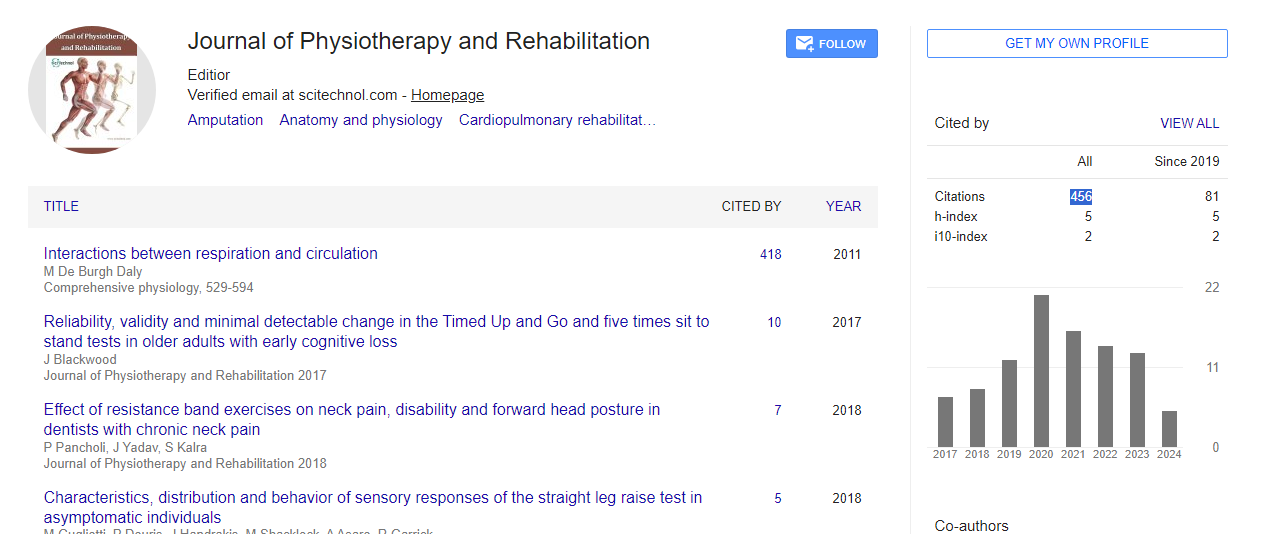Commentary, J Physiother Rehabi Vol: 8 Issue: 3
Balance and Fall Prevention Strategies in Geriatric Physical Therapy
Trine Gade*
1Department of Orthopaedic Surgery, University of Pittsburgh Medical Center, Pittsburgh, USA
*Corresponding Author: Trine Gade,
Department of Orthopaedic Surgery,
University of Pittsburgh Medical Center, Pittsburgh, USA
E-mail: gade@tr.edu
Received date: 28 May, 2024, Manuscript No. JPTR-24-140161;
Editor assigned date: 30 May, 2024, PreQC No. JPTR-24-140161 (PQ);
Reviewed date: 13 June, 2024, QC No. JPTR-24-140161;
Revised date: 21 June, 2024, Manuscript No. JPTR-24-14016 (R);
Published date: 28 June, 2024, DOI: 10.4172/JPTR.1000170.
Citation: Gade T (2024) Balance and Fall Prevention Strategies in Geriatric Physical Therapy. J Physiother Rehabi 8:3.
Description
Maintaining balance and preventing falls are critical priorities in geriatric physical therapy, as these issues significantly impact the health, independence, and quality of life of older adults. Falls are a major health concern among older adults, contributing to injuries, hospitalizations, loss of independence, and increased mortality rates. According to the World Health Organization (WHO), falls are the second leading cause of accidental or unintentional injury deaths worldwide among seniors. Factors such as age-related changes in balance, muscle weakness, chronic health conditions, medication side effects, and environmental hazards increase the risk of falls in this population.
Role of geriatric physical therapy
Geriatric physical therapy focuses on optimizing functional mobility, enhancing physical strength and endurance, and reducing fall risk through evidence-based interventions. The primary goals include improving balance, increasing muscle strength, promoting proprioception (awareness of body position), and addressing sensory deficits to enhance stability and prevent falls. Physical therapists utilize functional balance tests to evaluate an individual's balance and mobility capabilities. Common assessment tools include the Berg Balance Scale, Timed Up and Go Test (TUG), Dynamic Gait Index (DGI), and Performance-Oriented Mobility Assessment (POMA). These tests assess various aspects of balance control, gait stability, and functional mobility, providing valuable insights into fall risk and guiding personalized treatment planning.
A comprehensive physical examination includes assessing muscle strength, joint range of motion, sensory function (e.g., proprioception, vision), cardiovascular fitness, and functional capacity. Therapists also evaluate posture, walking patterns, and the presence of orthopedic or neurological impairments that may contribute to balance deficits and fall risk. Strength and resistance training exercises are fundamental components of fall prevention programs. Targeted exercises focus on improving lower extremity strength, core stability, and muscle coordination to enhance balance and stability during daily activities. Therapists prescribe exercises such as squats, lunges, heel-to-toe walking, and balance drills using stability balls or foam pads to challenge proprioception and improve postural control.
Gait training sessions emphasize proper walking mechanics, stride length, and rhythmic movement patterns. Physical therapists incorporate gait retraining exercises, functional walking drills, and obstacle navigation to improve walking speed, endurance, and dynamic balance. Assistive devices such as walkers or canes may be recommended to enhance stability and reduce fall risk in individuals with mobility impairments. Therapists assess home and community environments for potential hazards that may contribute to falls, such as uneven surfaces, poor lighting, clutter, or lack of handrails. They provide recommendations for environmental modifications, including installing grab bars, improving lighting conditions, removing tripping hazards, and arranging furniture to facilitate safe movement and reduce fall risks.
Patient education is integral to fall prevention strategies. Physical therapists educate older adults and caregivers about fall risk factors, proper use of assistive devices, strategies for safe mobility, and techniques to recover from a fall safely. They emphasize the importance of regular physical activity, medication management, vision checks, and maintaining a healthy diet to optimize overall health and reduce fall incidence. Effective fall prevention in geriatric physical therapy involves collaboration with other healthcare professionals, including physicians, occupational therapists, pharmacists, and community resources. A multidisciplinary approach ensures comprehensive assessment, personalized interventions, and continuity of care to address the complex needs of older adults and enhance outcomes related to balance and fall prevention.
Conclusion
Balance and fall prevention strategies are essential components of geriatric physical therapy, aiming to enhance functional independence, reduce fall risk, and improve overall quality of life for older adults. By employing evidence-based assessments, personalized exercise programs, environmental modifications, and patient education, physical therapists play a important role in mitigating fall-related injuries and promoting safe, active aging. Continued research, professional education, and community outreach are vital to advancing fall prevention efforts and ensuring optimal care for older adults worldwide.
 Spanish
Spanish  Chinese
Chinese  Russian
Russian  German
German  French
French  Japanese
Japanese  Portuguese
Portuguese  Hindi
Hindi 